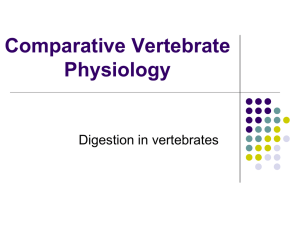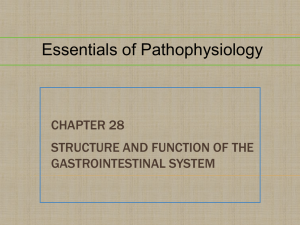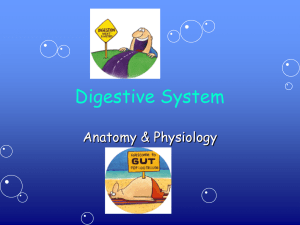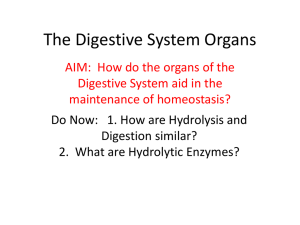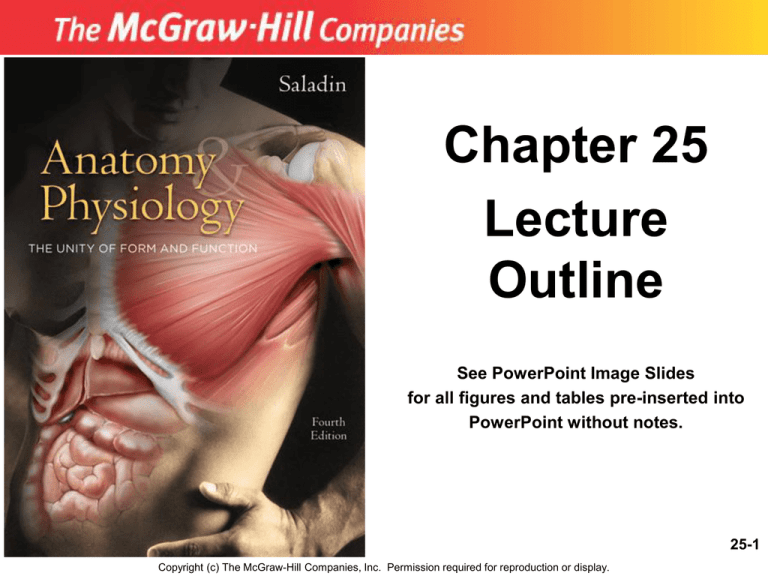
Chapter 25
Lecture
Outline
See PowerPoint Image Slides
for all figures and tables pre-inserted into
PowerPoint without notes.
25-1
Copyright (c) The McGraw-Hill Companies, Inc. Permission required for reproduction or display.
The Digestive System
•
•
•
•
•
•
•
General anatomy and digestive processes
Mouth through esophagus
Stomach
Liver, gallbladder and pancreas
Small intestine
Chemical digestion and absorption
Large intestine
25-2
Digestive Functions
• Ingestion
– intake of food
• Digestion
– breakdown of molecules
• Absorption
– uptake nutrients into blood/lymph
• Defecation
– elimination of undigested material
25-3
Stages of Digestion
• Mechanical digestion
– physical breakdown of food into smaller particles
– teeth and churning action of stomach and intestines
• Chemical digestion
– series of hydrolysis reactions that break
macromolecules into their monomers
– enzymes from saliva, stomach, pancreas and
intestines
– results
• polysaccharides into monosaccharides
• proteins into amino acids
• fats into glycerol and fatty acids
25-4
Digestive Processes
• Motility
– muscular contractions that break up food, mix
it with enzymes and move it along
• Secretion
– digestive enzymes and hormones
• Membrane transport
– absorption of nutrients
25-5
Subdivisions of Digestive System
• Digestive tract
(GI tract)
– 30 foot long
muscular tube
extending from
mouth to anus
• Accessory
organs
– teeth, tongue,
liver, gallbladder,
pancreas,
salivary glands
25-6
Tissue Layers of GI Tract
• Mucosa
– epithelium
– lamina propria
– muscularis mucosae- thin layer of smooth muscle
• Submucosa- thicker layer of loose connective
tissue (contains blood vessels, lymph, nerves, glands)
• Muscularis externa
2 layers of muscle near the outer surface
– inner circular layer- sphincters
– outer longitudinal layer- motility that propels food
• Serosa
– Thin layer of areolar tissue topped by a simple
squamous mesothelium
25-7
Tissue Layers of GI Tract
25-8
Enteric Nervous Control
• Able to function independently of CNS
• Composed of two nerve networks
– submucosal plexus
• controls glandular secretion of mucosa
• contractions of muscularis mucosae
– myenteric plexus
• controls peristalsis
• contractions of muscularis externa
25-9
Relationship to Peritoneum
• Only duodenum, pancreas and parts of
large intestine are retroperitoneal
• Dorsal mesentery suspends GI tract and
forms serosa (visceral peritoneum) of
stomach and intestines
• Ventral mesentery forms lesser and greater
omentum
– lacy layer of connective tissue that contains
lymph nodes, lymphatic vessels, blood vessels
25-10
Lesser and Greater Omentum
• Lesser - attaches stomach to liver
• Greater - covers small intestines like an apron
25-11
Mesentery and Mesocolon
• Mesentery of small intestines holds many blood vessels
25-12
• Mesocolon anchors colon to posterior body wall
Regulation of Digestive Tract
• Neural control
– short myenteric reflexes (swallowing)
– long vagovagal reflexes (parasympathetic
stimulation of digestive motility and secretion)
• Hormones
– messengers diffuse into bloodstream, distant
targets (ex. gastrin, secretin)
• Paracrine secretions
– messengers diffuse to nearby target cells
ex. histamine and prostaglandins
25-13
Mouth or Oral Cavity
25-14
Features of Oral Cavity
• Cheeks and lips
– keep food between teeth for chewing;
essential for speech and suckling in infants
– vestibule - space between teeth and cheeks
– lips: cutaneous area versus red area (vermilion)
• Tongue is sensitive, muscular manipulator
of food
– papillae and taste buds on dorsal surface
– lingual glands secrete saliva, tonsils in root
• Hard and soft palate
– allow breathing and chewing at same time
– palatoglossal and palatopharyngeal arches
25-15
Dentition
• Baby teeth (20) by 2 years; Adult (32) between 6 and 25
25-16
• Occlusal surfaces and cusp numbers differ
Permanent and Deciduous Teeth
25-17
Tooth Structure
• Periodontal ligament is
modified periosteum
– anchors into alveolus
• Cementum and dentin
are living tissue
• Enamel is noncellular
secretion formed during
development
• Root canal leads into
pulp cavity
– nerves and blood vessels
• Gingiva or gums
25-18
Mastication= Chewing
• Breaks food into smaller pieces to be
swallowed
– surface area exposed to digestive enzymes
• Contact of food with sensory receptors
triggers chewing reflex
– tongue, buccinator and orbicularis oris
manipulate food
– masseter and temporalis elevate the teeth to
crush food
– medial and lateral pterygoids swing teeth in
side-to-side grinding action of molars
25-19
Saliva
• Functions of saliva
– moisten, begin starch and fat digestion, cleanse
teeth, inhibit bacteria, bind food together into bolus
• Hypotonic solution of 99.5% water and solutes
–
–
–
–
–
–
salivary amylase, begins starch digestion
lingual lipase, digests fat -activated by stomach acid
mucus, aids in swallowing
lysozyme, enzyme kills bacteria
immunoglobulin A, inhibits bacterial growth
electrolytes = Na+, K+, Cl-, phosphate and bicarbonate
• pH of 6.8 to 7.0
25-20
Salivary Glands
• Small intrinsic glands found under mucous membrane of
mouth, lips, cheeks and tongue - secrete at constant rate
• 3 pairs extrinsic glands connected to oral cavity by ducts
– parotid, submandibular and sublingual
25-21
Histology of Salivary Glands
• Compound tubuloacinar glands
• Mucous cells secrete mucus
• Serous cells secrete thin fluid
rich in amylase
• Mixed acinus has both
25-22
Salivation
• Total of 1 to 1.5 L of saliva per day
• Cells filter water from blood and add other
substances
• Food stimulates receptors that signal salivatory
nuclei in medulla and pons
– parasympathetic stimulation salivary glands produce
thin saliva, rich in enzymes
– sympathetic stimulation produce less abundant,
thicker saliva, with more mucus
• Higher brain centers stimulate salivatory nuclei so
sight, smell and thought of food cause salivation
25-23
Pharynx
• Skeletal muscle
– deep layer – longitudinal orientation
– superficial layer – circular orientation
• superior, middle and inferior pharyngeal
constrictors
25-24
Esophagus
• Straight muscular tube 25-30 cm long
– nonkeratinized stratified squamous epithelium
– esophageal glands in submucosa
– skeletal muscle in upper part and smooth in bottom
• Extends from pharynx to cardiac stomach
passing through esophageal hiatus in diaphragm
– inferior pharyngeal constrictor excludes air from it
• Lower esophageal sphincter closes orifice to
reflux
25-25
Swallowing p976
25-26
Swallowing (Deglutition)
• Series of muscular contractions coordinated by
center in medulla and pons
– motor signals from cranial nerves V, VII, IX and XII
• Buccal phase
– tongue collects food and pushes it back into
oropharynx
• Pharyngeal-esophageal phase
– soft palate rises and blocks nasopharynx
– infrahyoid muscles lift larynx; epiglottis folded back
– pharyngeal constrictors push bolus down esophagus
• liquids in 2 seconds -- food bolus may take 8 seconds
• lower esophageal sphincter relaxes
25-27
X-ray: Swallowing in Esophagus
25-28
Stomach
• Mechanically breaks up food, liquifies
food and begins chemical digestion of
protein and fat
– resulting soupy mixture is called chyme
• Does not absorb significant amount of
nutrients
– absorbs aspirin and some lipid-soluble drugs
– absorbs alcohol efficiently
25-29
Gross Anatomy of Stomach
• Muscular sac (internal volume from 50ml to 4L)
– J - shaped organ with lesser and greater
curvatures
– regional differences
• cardiac region just inside cardiac orifice
• fundus - domed portion superior to esophageal
opening
• body - main portion of organ
• pyloric region - narrow inferior end
– antrum and pyloric canal
• Pylorus - opening to duodenum
– thick ring of smooth muscle forms a sphincter
25-30
Innervation and Circulation
• Innervation by
– parasympathetic fibers from vagus
– sympathetic fibers from celiac plexus
• All blood from stomach enters hepatic
portal circulation and is filtered through
liver before returning to heart
25-31
Gross Anatomy of Stomach
• Notice: bulge of fundus, narrowing of pyloric
region, thickness of pyloric sphincter and
greater and lesser curvatures
25-32
Gross Anatomy of Stomach
25-33
Unique Features of Stomach Wall
• Mucosa
– simple columnar glandular epithelium
– lamina propria is filled with tubular glands (gastric pits)
• Muscularis externa has 3 layers
– outer longitudinal, middle circular and inner oblique layers
25-34
Gastric Gland
25-35
Cells of Gastric Glands
• Mucous cells secrete mucus
• Regenerative cells
– divide rapidly to produce new cells
that migrate to surface
• Parietal cells
– secrete HCl acid and intrinsic factor
• Chief cells
– secrete pepsinogen and gastric
lipase
• Enteroendocrine cells
– secrete hormones and paracrine
messengers
25-36
Opening of Gastric Pit
25-37
Gastric Secretions
• 2 to 3 L of gastric juice/day (H2O, HCl and pepsin)
• Parietal cells contain carbonic anhydrase (CAH)
CAH
– CO2 + H2O H2CO3 HCO3- + H+
– H+ is pumped into stomach lumen by H+K+ATPase
• antiporter uses ATP to pump H+ out and K+ in
– HCO3- exchanged for Cl- (chloride shift)
• Cl- pumped out to join H+ forming HCl
• HCO3- in blood causes alkaline tide (blood pH )
25-38
Functions of Hydrochloric Acid
• Activates pepsin and lingual lipase
• Breaks up connective tissues and plant
cell walls
– liquefies food to form chyme
• Converts ingested ferric ions (Fe3+) to
ferrous ions (Fe2+)
– absorbed and used for hemoglobin synthesis
• Destroys ingested bacteria and pathogens
25-39
Gastric Enzymes and Intrinsic Factor
(see table 25.1 p. 982)
• Intrinsic factor
– essential for B12 absorption by small intestine
– without Vitamin B12, hemoglobin cannot be
synthesized (lack causes pernicious anemia)
• Pepsin - protein digestion
– secreted as pepsinogen (inactive)
– HCl converts it to pepsin (active)
• Gastric lipase
– This enzyme and lingual lipase digest 10-15%
of dietary fat in stomach (rest digested in
25-40
small intestine)
Production and Action of Pepsin
p. 982
25-41
Chemical Messengers
• Many produced by enteroendocrine cells
– hormones enter blood distant cells
– paracrine secretions neighboring cells
• Gut-brain peptides
– signaling molecules produced in digestive
tract and CNS
25-42
Gastric Motility
• Swallowing center signals stomach to relax
• Food stretches stomach activating a receptiverelaxation response
– resists stretching briefly, but relaxes to hold more food
• Rhythm of peristalsis controlled by pacemaker
cells in longitudinal muscle layer
– gentle ripple of contraction every 20 seconds churns
and mixes food with gastric juice
– stronger contraction at pyloric region; ejects 3 ml
– typical meal emptied from stomach in 4 hours
25-43
Vomiting
• Induced by
– excessive stretching of stomach, psychological or sensory
stimuli or chemical irritants (such as alcohol and bacterial
toxins), visceral trauma, intense pain
• Emetic center in medulla causes
– retching
• lower esophageal sphincter to relax
• stomach and duodenum to contract spasmodically
– vomiting
• when abdominal contraction forces upper
esophageal sphincter to open
25-44
Healthy Mucosa and Peptic Ulcer
25-45
Regulation of Gastric Secretion
p. 985
25-46
Regulation of Gastric Function
(Phases 1-2) see page 985
• Cephalic phase
– sight, smell, taste or thought of food; vagus
nerve stimulates gastric secretion and motility
• Gastric phase
– activated by presence of food or semidigested
protein
• by stretch or in pH
– secretion stimulated by
• ACh (from parasympathetic fibers), histamine (from gastric
enteroendocrine cells) and gastrin (from pyloric G cells)
– receptors on parietal and chief cells
25-47
Regulation of Gastric Function
(Phase 3)
• Intestinal phase - duodenum regulates gastric
activity through hormones and nervous reflexes
– at first gastric activity increases (if duodenum is
stretched or amino acids in chyme cause gastrin
release)
– enterogastric reflex - duodenum inhibits
stomach
• caused by acid and semi-digested fats in duodenum
– chyme stimulates duodenal cells to release
secretin, cholecystokinin (CCK) and gastric
inhibitory peptide
• all 3 suppress gastric secretion and motility
25-48
Positive Feedback Control- Gastric Secretion
p. 985
25-49
Liver, Gallbladder and Pancreas
• All release important secretions into small
intestine to continue digestion
25-50
Gross Anatomy of Liver
• 3 lb. organ located inferior to the diaphragm
• 4 lobes - right, left, quadrate and caudate
– falciform ligament separates left and right
– round ligament, remnant of umbilical vein
• Gallbladder adheres to ventral surface between
right and quadrate lobes
25-51
Inferior Surface of Liver
25-52
Microscopic Anatomy of Liver
• Tiny cylinders called hepatic lobules (2mm by 1mm)
• Central vein surrounded by sheets of hepatocyte cells
separated by sinusoids lined with fenestrated epithelium
• Blood filtered by hepatocytes on way to central vein 25-53
Histology of Liver - Hepatic Triad
• 3 structures found in corner between lobules
– hepatic portal vein and hepatic artery bring blood to liver
– bile duct collects bile from bile canaliculi between sheets of
hepatocytes to be secreted from liver in hepatic ducts
25-54
Ducts of Gallbladder, Liver and
Pancreas
25-55
Ducts of Gallbladder, Liver, Pancreas
• Bile passes from bile canaliculi between cells to
bile ductules to right and left hepatic ducts
• Right and left ducts join outside liver to form
common hepatic duct
• Cystic duct from gallbladder joins common
hepatic duct to form bile duct
• Duct of pancreas and bile duct combine to form
hepatopancreatic ampulla emptying into
duodenum at major duodenal papilla
– sphincter of Oddi (hepatopancreatic sphincter)
regulates release of bile and pancreatic juice
25-56
Gallbladder and Bile
• Sac on underside of liver -- 10 cm long
• 500 to 1000 mL bile are secreted daily from liver
• Gallbladder stores and concentrates bile
– bile backs up into gallbladder from a filled bile duct
– between meals, bile is concentrated by factor of 20
• Yellow-green fluid containing minerals, bile acids,
cholesterol, bile pigments and phospholipids
– bilirubin pigment from hemoglobin breakdown
• intestinal bacteria convert to urobilinogen = brown color
– bile acid (salts) emulsify fats and aid in their digestion
• enterohepatic circulation - recycling of bile acids from ileum
25-57
Gross Anatomy of Pancreas
• Retroperitoneal gland posterior to stomach
– head, body and tail
• Endocrine and exocrine gland
– secretes insulin and glucagon into the blood
– secretes 1500 mL pancreatic juice into duodenum
• water, enzymes, zymogens, and sodium bicarbonate
– other pancreatic enzymes are activated by exposure to bile and
ions in the intestine
• Pancreatic duct runs length of gland to open at
sphincter of Oddi
– accessory duct opens independently on duodenum
25-58
Pancreatic Acinar Cells
• Zymogens =
proteases
– trypsinogen
– chymotrypsinogen
– procarboxypeptidase
• Other enzymes
– pancreatic amylase
– pancreatic lipase
– ribonuclease and
deoxyribonuclease
See Table 25.2 p. 991
25-59
Activation of Zymogens
p. 991
• Trypsinogen converted to trypsin by intestinal epithelium
• Trypsin converts other 2 (also digests dietary protein) 25-60
Hormonal Control of Secretion
• Cholecystokinin released from duodenum
in response to arrival of acid and fat
– causes contraction of gallbladder, secretion of
pancreatic enzymes, relaxation of
hepatopancreatic sphincter
• Secretin released from duodenum in
response to acidic chyme
– stimulates all ducts to secrete more
bicarbonate
• Gastrin from stomach and duodenum
weakly stimulates gallbladder contraction
and pancreatic enzyme secretion
25-61
Small Intestine
• Nearly all nutrient absorption occurs in small
intestine (jejunum)
25-62
Small Intestine
• Duodenum curves around head of pancreas
(10 in.)
– retroperitoneal along with pancreas
– receives stomach contents, pancreatic juice and bile
– neutralizes stomach acids, emulsifies fats, pepsin
inactivated by pH increase, pancreatic enzymes
• Jejunum - next 8 ft. (in upper abdomen)
– has large tall circular folds; walls are thick, muscular
– most nutrient absorption occurs here
• Ileum - last 12 ft. (in lower abdomen)
– has peyer’s patches – clusters of lymphatic nodules
– ends at ileocecal junction with large intestine
25-63
Small Intestine - Surface Area
• Circular folds (plicae circularis) up to 10 mm tall
– involve only mucosa and submucosa
– chyme flows in spiral path causing more contact
• Villi are fingerlike
projections 1 mm tall
– contain blood vessels and
lymphatics (lacteal)
• nutrient absorption
• Microvilli 1 micron tall;
cover surface
– brush border on cells
– brush border enzymes for
final stages of digestion
25-64
Intestinal Crypts
• Pores opening between villi lead
to intestinal crypts
– absorptive cells, goblet cells and at
base, rapidly dividing cells
• life span of 3-6 days as migrate up to
surface and get sloughed off and
digested
– paneth cells – antibacterial secretions
• Brunner’s glands in submucosa
secrete bicarbonate mucus
• Peyer patches are populations of
lymphocytes to fight pathogens
• Secrete 1-2 L of intestinal juice/day
– water and mucus, pH 7.4-7.8
– See page 994, Fig 25.25
25-65
Intestinal Villi
Villi of Jejunum
Histology of duodenum
25-66
Intestinal Motility
1. Mixes chyme with intestinal juice, bile and
pancreatic juice
2. Churns chyme to increase contact with mucosa
for absorption and digestion
3. Moves residue towards large intestine
– segmentation
•
•
random ringlike constrictions mix and churn contents
12 times per minute in duodenum
– peristaltic waves begin in duodenum but each one
moves further down
•
•
•
push chyme along for 2 hours
suppressed by refilling of stomach
Food in stomach causes gastroileal reflex
(relaxing of valve and filling of cecum)
25-67
Segmentation in Small Intestine
• Purpose of segmentation is to mix and churn not to
move material along as in peristalsis
25-68
Peristalsis
• Gradual movement of
contents towards
colon
• Begins after
absorption occurs
• Migrating motor
complex controls
waves of contraction
– second wave begins
distal to where first
wave began
25-69
Carbohydrate Digestion - Small Intestine
• Salivary amylase stops working in stomach (pH < 4.5)
– 50% of dietary starch digested before it reaches small intestine
• Pancreatic amylase completes first step in 10 minutes
• Brush border enzymes act upon oligosaccharides,
maltose, sucrose, lactose and fructose
25-70
– lactose indigestible after age 4 in most humans (lactase declines)
Carbohydrate Absorption
• Sodium-glucose transport proteins (SGLT) in membrane
help absorb glucose and galactose
• Fructose absorbed by facilitated diffusion then
25-71
converted to glucose inside the cell
Protein Digestion and Absorption
p. 998
• Pepsin has optimal pH of 1.5 to 3.5 -- inactivated
when passes into duodenum and mixes with
25-72
alkaline pancreatic juice (pH 8)
Protein Digestion and Absorption
• Pancreatic enzymes take over protein digestion by
hydrolyzing polypeptides into shorter oligopeptides
25-73
Protein Digestion and Absorption
• Brush border enzymes finish task, producing amino acids
that are absorbed into intestinal epithelial cells
– amino acid cotransporters move into epithelial cells and facilitated
diffusion moves amino acids out into blood stream
• Infants absorb proteins by pinocytosis (maternal IgA)
25-74
Fat Digestion and Absorption
p. 1000
25-75
Fat Digestion and Absorption
25-76
Fat Digestion and Absorption
25-77
Fat absorption
• Although some FFAs enter the blood
capillaries, chylomicrons are too large to
penetrate the endothelium
• They are taken up by the more porous
lacteal into the lymph. The white, fatty
intestinal lymph (chyle) flows through
larger and larger lymphatic vessels,
eventually enters bloodstream at the left
subclavian vein
25-78
Nucleic Acids, Vitamins, and Minerals
• Nucleases hydrolyze DNA and RNA to
nucleotides
– nucleosidases and phosphatases of brush border
split them into phosphate ions, ribose or
deoxyribose sugar and nitrogenous bases
• Vitamins are absorbed unchanged
– A, D, E and K with other lipids -- B complex and C by
simple diffusion and B12 if bound to intrinsic factor
• Minerals are absorbed all along small intestine
– Na+ cotransported with sugars and amino acids
– Cl- exchanged for bicarbonate reversing stomach
– Iron and calcium absorbed as needed
25-79
Water Balance
• Digestive tract receives about 9 L of water/day
– .7 L in food, 1.6 L in drink, 6.7 L in secretions
– 8 L is absorbed by small intestine and 0.8 L by large
intestine
• Water is absorbed by osmosis following the
absorption of salts and organic nutrients
• Diarrhea occurs when too little water is
absorbed
– feces pass through too quickly if irritated
– feces contains high concentrations of a solute
(lactose)
25-80
Anatomy of Large Intestine
25-81
Gross Anatomy of Large Intestine
• 5 feet long and 2.5 inches in diameter in
cadaver
• Begins as cecum and appendix in lower
right corner
• Ascending, transverse and descending
colon frame the small intestine
• Sigmoid colon is S-shaped portion leading
down into pelvis
• Rectum - straight portion ending at anal
25-82
canal
Microscopic Anatomy
• Mucosa - simple columnar epithelium
– anal canal has stratified squamous epithelium
• No circular folds or villi to increase surface area
• Intestinal crypts (glands sunken into lamina
propria) produce mucus only
• Muscularis externa
– muscle tone in longitudinal muscle fibers
(concentrated in taeniae coli) form pouches (haustra)
• Transverse and sigmoid have a serosa, rest
retroperitoneal
– epiploic appendages are suspended fatty sacs
25-83
Bacterial Flora and Intestinal Gas
• Bacterial flora populate large intestine
– ferment cellulose and other undigested
carbohydrates; we absorb resulting sugars
– synthesize vitamins B and K
• Flatus (gas)
– average person produces 500 mL per day
– most is swallowed air but hydrogen sulfide,
indole and skatole produce odor
25-84
Absorption and Motility
• Transit time is 12 to 24 hours
– reabsorbs water and electrolytes
• Feces consist of water and solids (bacteria,
mucus, undigested fiber, fat and sloughed
epithelial cells
• Haustral contractions occur every 30 minutes
– distension of a haustrum stimulates it to contract
• Mass movements occur 1 to 3 times a day
– triggered by gastrocolic and duodenocolic reflexes
• filling of the stomach and duodenum stimulates motility
• moves residue for several centimeters with each contraction
25-85
Anatomy of Anal Canal
• Anal canal is 3 cm total length
• Anal columns are longitudinal ridges separated
by mucus secreting anal sinuses
• Hemorrhoids are permanently distended veins 25-86
Defecation
• Stretching of the rectum stimulates defecation
– intrinsic defecation reflex via the myenteric plexus
• causes muscularis to contract and internal sphincter to relax
– relatively weak contractions
• defecation occurs only if external anal sphincter is
voluntarily relaxed
– parasympathetic defecation reflex involves spinal
cord
• stretching of rectum sends sensory signals to spinal cord
• splanchnic nerves return signals intensifying peristalsis
• Abdominal contractions increase abdominal
pressure as levator ani lifts anal canal upwards
– feces will fall away
25-87
Neural Control of Defecation
1. Filling of the rectum
2. Reflex contraction of
rectum and
relaxation of internal
anal sphincter
3. Voluntary relaxation
of external sphincter
25-88






